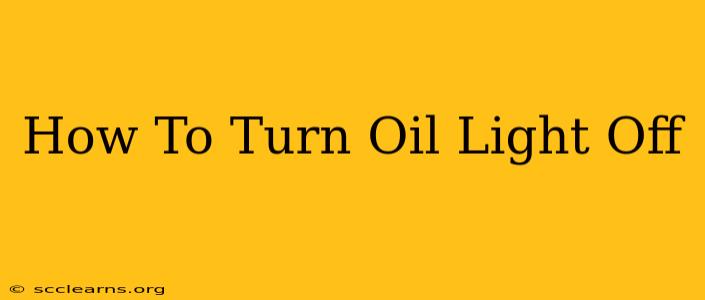Seeing that dreaded oil light illuminate on your dashboard is never a good sign. It indicates a serious problem with your vehicle's lubrication system, and ignoring it could lead to catastrophic engine damage. This guide will explore the causes of an illuminated oil light, how to safely address the issue, and when you absolutely need professional help. Remember: Never attempt to drive a car with an illuminated oil light unless you're absolutely certain of the cause and have taken the necessary steps to rectify the situation.
Understanding Your Oil Light
The oil light, often depicted as an oil can with a drop or a pressure gauge, serves as a critical warning system. It signifies a problem with your engine's oil pressure, which is essential for lubricating moving parts and preventing friction-induced damage. A low oil pressure situation can quickly lead to a seized engine, a costly repair.
Common Causes of an Oil Light
Several factors can trigger your oil light to come on. Let's break them down:
-
Low Oil Level: This is the most common culprit. Your engine simply doesn't have enough oil to maintain proper pressure. Check your dipstick!
-
Oil Leak: A leak in your engine, oil pan, or elsewhere in the oil system can cause a pressure drop, triggering the light. This often requires professional attention.
-
Faulty Oil Pressure Sensor: This sensor measures the oil pressure and sends a signal to your dashboard. A malfunctioning sensor can trigger the light even if the oil pressure is fine.
-
Clogged Oil Filter: A clogged filter restricts oil flow, leading to reduced pressure. Changing your oil filter regularly is crucial preventative maintenance.
-
Worn-Out Oil Pump: The oil pump circulates the oil. If it's failing, it won't be able to maintain sufficient pressure. This is a serious problem and demands immediate professional attention.
Troubleshooting Your Oil Light: Safe Steps
Before you even think about starting your car, let's clarify something important: If your oil light comes on while driving, pull over to a safe location IMMEDIATELY and turn off the engine. Continuing to drive with a low oil pressure situation can irreparably damage your engine.
1. Check Your Oil Level: This is the first and most important step. Locate your dipstick (usually yellow or bright orange), remove it, wipe it clean, reinsert it fully, and then remove it again to check the oil level. If it's low, add the correct type and amount of oil as specified in your owner's manual. Never overfill.
2. Inspect for Leaks: Carefully examine your engine and the surrounding area for any signs of oil leaks – wet spots, drips, or stains. This might require a flashlight and careful observation.
3. Check the Oil Filter: While less likely to be the sole cause, a severely clogged oil filter can contribute to low pressure. If you're comfortable doing so, replace the filter (following your owner's manual instructions). Be aware of proper disposal methods for used oil and filters.
When Professional Help Is Absolutely Necessary
Some situations require immediate professional help. Don't attempt to fix these yourself:
-
Persistent Oil Light After Adding Oil: If you add oil and the light remains on, there's likely a more serious underlying problem.
-
Obvious Oil Leaks: Significant leaks require professional diagnosis and repair to locate the source and prevent further damage.
-
Unusual Engine Noises: If you hear knocking, ticking, or other unusual noises, your engine might be suffering from damage due to low oil pressure. Stop driving immediately.
-
Lack of Mechanical Experience: If you're not mechanically inclined, it's best to leave any oil light troubleshooting to qualified mechanics.
Preventing Future Oil Light Issues
Regular maintenance is key to preventing oil light issues:
-
Regular Oil Changes: Follow your owner's manual recommendations for oil change intervals.
-
Oil Filter Replacement: Change your oil filter with every oil change.
-
Regular Inspections: Periodically check your oil level using the dipstick.
-
Address Leaks Promptly: Fix oil leaks as soon as you notice them.
Ignoring an illuminated oil light is a risky gamble. By understanding the possible causes and taking the appropriate steps, you can help protect your engine and avoid costly repairs. Remember to prioritize safety and seek professional help when needed.

